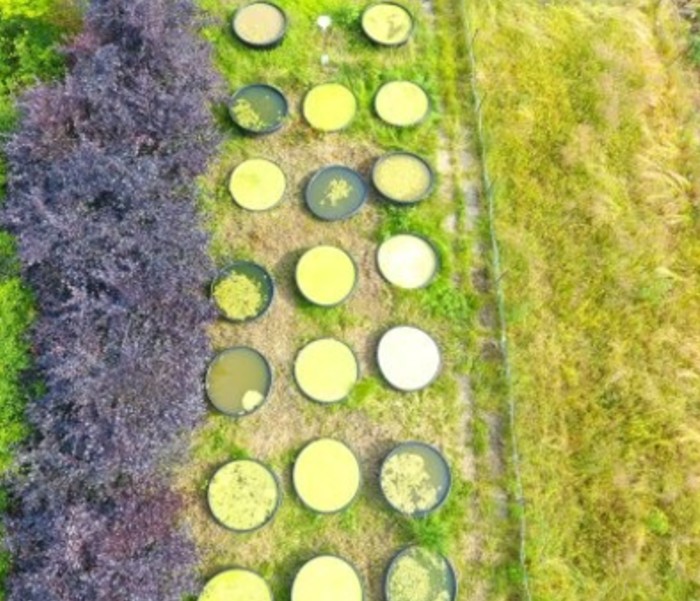Scientists at the University of Stirling have been able to unpick what determines the size and evolution of disease in a first-of-its-kind study.
The research team – led by Dr Stuart Auld, a Biological and Environmental Sciences expert in the Faculty of Natural Sciences – used clones of a crustacean to explore whether epidemics could be repeated, and to what scale in different environments.
The scientists used Daphnia magna – a crustacean that can clone itself – to repeatedly run epidemics starting with the same population of hosts and pathogens in different environments, to test how various factors determined epidemic size and disease evolution.

The experiment photographed from above
They set up controlled laboratory experiments – creating complex natural environments using ponds containing Daphnia and its sterilizing bacterial pathogen Pasteuria ramosa – and were able to show precisely how these ecological conditions interacted and impacted the size of epidemics, and how the epidemics altered the hosts’ ability to resist the bacterium, and bacterial infectiousness.
The study, which was funded by the Natural Environment Research Council (NERC), is published in the journal Nature Ecology and Evolution.

Biological and Environmental Sciences, Faculty of Natural Sciences
This study is almost unheard of – it was like examining the Black Death 16 times over, but each time under different environmental conditions. We were able to show that epidemics aren’t random processes; they are repeatable and predictable when you know a bit about the wider environment.
Dr Auld, who was supported by PhD student Sam Paplauskas and technician June Brand, said “We know that epidemics vary: the Black Death was worse than the Great Plague of London despite being caused by the same bacterium, but it’s hard to know why. In our study, we were essentially able to put the same animal into different environments and see how susceptible it was to infection. Each pond differed in its temperature profile and all manner of other ecological conditions, but the starting set of hosts and pathogens was the same.
“This study is almost unheard of – it was like examining the Black Death 16 times over, but each time under different environmental conditions. We were able to show that epidemics aren’t random processes; they are repeatable and predictable when you know a bit about the wider environment.”
Predicting epidemics
The researchers found that measuring 10 ecological variables, including temperature, pH, access to algal food and predator densities, enabled them to predict when epidemics were going to be large or small. They were also able to foresee the direction and extent of overall disease coevolution – the extent to which hosts evolved to be resistant and pathogens evolved to become more infectious.
The study ‘Ecology directs host–parasite coevolutionary trajectories across Daphnia–microparasite populations’ is part of the wider Stirling Outdoor Disease Experiment project – a long-term experiment that uses replicate pond populations of a crustacean and its bacterial disease to examine how ecological and environmental variation affects disease evolution.
Dr Auld added: “Following the outbreak of COVID-19 and the way it has dramatically impacted our lives, disease evolution is now very much of interest to the general public. We must better understand the general underlying processes that govern the size and severity of disease outbreaks. Any underlying knowledge that helps us better predict disease dynamics – for human, animal and crop diseases – will ultimately be of benefit to society.”

